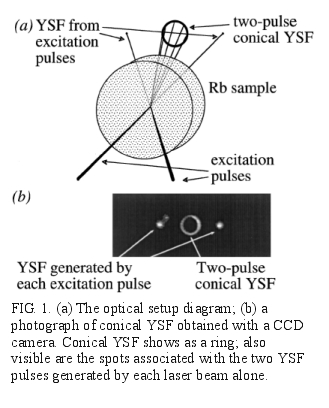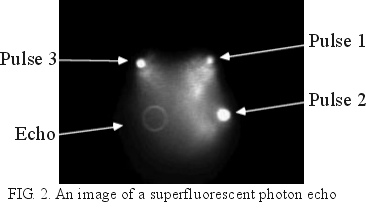Omnidirectional
superfluorescence transients
Alexander Lvovsky, Sven
Hartmann, Fred Moshary
This work has been done during
the last year of my PhD research and became the main subject of my dissertation. Based on our results, we have
published two Physical Review Letters.

A sample of atomic rubidium, two-photon excited, in a large Fresnel number
geometry, into a coherent superposition between levels 5S and 5D, produces a
coherent flash of omnidirectional superfluorescence on the 5D -> 6P
transition. This involves a coherent population transfer to the 6P level
and results in a prompt directional UV emission along 6P->5S, a
phenomenon known as yoked superfluorescence (YSF). The
direction(s) of the lower transition emission is determined by the
wavevector(s) of the coherent superposition state between 5S and 5D in which
the system has been prepared.
Two examples were studied.
In the first, the sample was excited by two simultaneous non-collinear laser
pulses. The coherent superposition between levels 5S and 5D is
established due to absorption of one photon from each pulse. It results in a
conical emission pattern whose apex angle is a function of the angle between
the excitation beams (Fig. 1). The conical emission reminds that observed in
parametric four-wave mixing (PFWM) [1], but the physics in our case is very
different. The PFWM emission occurs in the presence of the pump field and is
conical on both upper and lower transition. In our case, on the other hand, the
pump and the two YSF fields are separated in time. As a result, the upper
transition superfluorescence in the phase matched direction is inhibited and
not enhanced [2]. The emission is conical on the lower transition but
omnidirectional on the upper. [paper 1]

As mentioned above, the lower transition superfluorescence occurs in the
directions determined, via phase matching, by the coherent superposition in
which the states 5S and 5D have been prepared. If the 5S state which existed
before the laser pulse contains some "prerecorded" coherence, it will
manifest itself in additional directions of the lower transition
emission. This coherence can be prepared, in the form of transient induced
grating, by a pair of laser pulses applied to the system substantially earlier
than the interrogating (third) pulse. This leads to the photon-echo type of emission
(Fig. 2) which differs from conventional photon echoes [3] by some unique
properties. First, it is generated by a spontaneous relaxation process
(superfluorescence). Second, it is a result of a two-photon resonant
excitation. Third, its frequency is not equal to that of the generating laser
pulses, nor their linear combination. Fourth, it is emitted in a cone. Fifth,
for it to be observed, excitation pulses do not have to comply with any
particular geometry. [paper 2]
1. W. R. Garrett, Laser Phys. 5, 466 (1994); W. R. Garrett, Phys. Rev.
Lett. 70, 4059-4062 (1993); M. A. Moore, W. R. Garrett, and M. G. Payne,
Opt. Commun. 68, 310 (1988).
2. J. H. Brownell, X. Lu, and S. R. Hartmann, Phys. Rev. Lett. 75, 3265 (1995)
3. N. A. Kurnit and S. R. Hartmann, Interaction of radiation with solids (Plenum
Press, New York, 1970); P. Hu, R. Leigh, and S. R. Hartmann, Phys. Lett. 40A,
164 (1972).